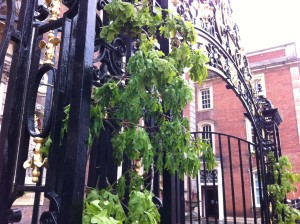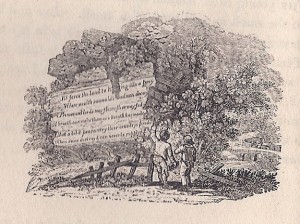 There are times when characters from Stone Ties climb to the top of Worcester Cathedral tower, each driven by a very different impulse. The tower is a place I visit often, but for those who’ve never climbed up there, here is a view looking down into the masons’ yard. The old stone wall, that marks the eastern boundary between the cathedral land and the city beyond, can be seen running diagonally down from the top right-hand corner. A door in the wall, still there today, allows access into the yard. Jacob knew it well.
There are times when characters from Stone Ties climb to the top of Worcester Cathedral tower, each driven by a very different impulse. The tower is a place I visit often, but for those who’ve never climbed up there, here is a view looking down into the masons’ yard. The old stone wall, that marks the eastern boundary between the cathedral land and the city beyond, can be seen running diagonally down from the top right-hand corner. A door in the wall, still there today, allows access into the yard. Jacob knew it well.
Oak Apple Day
 Oak Apple Day has a particularly sad resonance in Stone Ties. Dating back to the Act of Parliament of 1661, Royal Oak Day as it is also known, commemorated the day when King Charles II rode into London on his birthday, 29th May, in 1660, and restored the monarchy to England. The festival has resonated down the centuries, and in a handful of locations is still celebrated today. Worcester, a proudly Royalist city throughout the English civil war, continues to deck the gates of the Guildhall in oak leaves as a mark of respect and celebration.
Oak Apple Day has a particularly sad resonance in Stone Ties. Dating back to the Act of Parliament of 1661, Royal Oak Day as it is also known, commemorated the day when King Charles II rode into London on his birthday, 29th May, in 1660, and restored the monarchy to England. The festival has resonated down the centuries, and in a handful of locations is still celebrated today. Worcester, a proudly Royalist city throughout the English civil war, continues to deck the gates of the Guildhall in oak leaves as a mark of respect and celebration.
The Mason’s Mark
 In Stone Ties Simeon’s quest for the identity of the Northern Master exposes him to the mystery of masons’ marks. To this day their purpose continues to intrigue us. In common use amongst the banker masons (i.e. those that shaped the stones on their bench; the word banker being derived from the French banc, meaning a bench) the earliest examples can be dated to around the twelfth century. In the Middle Ages few craftsmen were literate, and the general use of surnames was not yet common, and so they left their unique mark upon the stone rather than their initials. It is believed the marks served two purposes, firstly to associate a stone with the mason who worked it, and secondly to evidence his output for payment reasons. Masons often developed their own marks by slightly altering those used by their father and grandfather. There are, sadly, very few examples in the records where a name and a mark have been linked. A number of marks can still be seen on the nave pillars within St. Edmund’s church in Southwold, Suffolk. Similar examples can be found in many other cathedrals and churches throughout Britain, but Wells Cathedral in Somerset has an especially fine collection.
In Stone Ties Simeon’s quest for the identity of the Northern Master exposes him to the mystery of masons’ marks. To this day their purpose continues to intrigue us. In common use amongst the banker masons (i.e. those that shaped the stones on their bench; the word banker being derived from the French banc, meaning a bench) the earliest examples can be dated to around the twelfth century. In the Middle Ages few craftsmen were literate, and the general use of surnames was not yet common, and so they left their unique mark upon the stone rather than their initials. It is believed the marks served two purposes, firstly to associate a stone with the mason who worked it, and secondly to evidence his output for payment reasons. Masons often developed their own marks by slightly altering those used by their father and grandfather. There are, sadly, very few examples in the records where a name and a mark have been linked. A number of marks can still be seen on the nave pillars within St. Edmund’s church in Southwold, Suffolk. Similar examples can be found in many other cathedrals and churches throughout Britain, but Wells Cathedral in Somerset has an especially fine collection.
Thomas Bewick and the Moorland Engraver
 Thomas Bewick, that doyen of English engravers, set the standard for engraving on wood, a standard yet to be surpassed. In particular he is renowned for his beautifully animated tailpieces, brimming with vivid depictions of every-day life in North East England. Amongst these are a number that depict inscriptions engraved upon the wild stone. The first edition of The Fables of Aesop published in 1818 has a particularly good collection. Whilst writing Stone Ties I had the engraving on page 28 of that edition, depicting a quotation from Goldsmith’s Deserted Village, in mind when I wrote about Carver’s Tom Paine engraving on the moors above Newcastle.
Thomas Bewick, that doyen of English engravers, set the standard for engraving on wood, a standard yet to be surpassed. In particular he is renowned for his beautifully animated tailpieces, brimming with vivid depictions of every-day life in North East England. Amongst these are a number that depict inscriptions engraved upon the wild stone. The first edition of The Fables of Aesop published in 1818 has a particularly good collection. Whilst writing Stone Ties I had the engraving on page 28 of that edition, depicting a quotation from Goldsmith’s Deserted Village, in mind when I wrote about Carver’s Tom Paine engraving on the moors above Newcastle.
Music, mood, and the involuntary impulse
One element helped me more than any other to define the two “modern” characters in Stone Ties. One thing above all helped me cement their personalities in my mind. And that thing was music.
For Simeon the one spiritual experience that came close to his love of stone was music and the music of Handel specifically. It was the only thing guaranteed to stimulate an involuntary, physical response; to raise the hairs on his arms, to immerse him in the moment. True Carver’s sculpture came close, as did Oxford’s splendid urban spaces. But Ombra Mai Fu? Well, you only have to listen to understand.
And so it was with Flora. No surprise that her chosen soundtrack to those quiet, intimate moments should be Alan Stivell and his ethereal harp. Take a listen to Ys, one of her favourites.
http://www.youtube.com/watch?v=T3eQA1rA1n4
And what of the author? Well either of the above would suit me well. But come the moment, Shay Fan Yan Ley by the glorious Linda Thompson lays me low. Sixty six seconds of bliss.
The seed of an idea and the role of the bathroom
It seemed only right to start this blog at the beginning. Obvious you say? Well indulge me for a moment. I’d written before; factual pieces mainly. But my desire to write fiction lay well hidden, like sleeping Arthur and his knights, waiting for the call. Surely all that was required was the appropriate catalyst, some spiritual awakening to stir the muse. A windswept hilltop, a serene meadow, a mysterious ruin perhaps? Hmm….
What is it about the humble bathroom that enables it to challenge the human imagination so? What songs, what verse, what tales owe their inception to its tiled and sterile influence?
And so there it happened, on a cold November morning, that most mundane of rooms planted the seed and set me loose. It planted six words that teased and annoyed me. It settled back, steamy and smug, and taunted me. “There you are…make sense of that” it said, “I dare you.”
Well what can you do? You can’t let it win.
Thank you bathroom. Until the next time……
